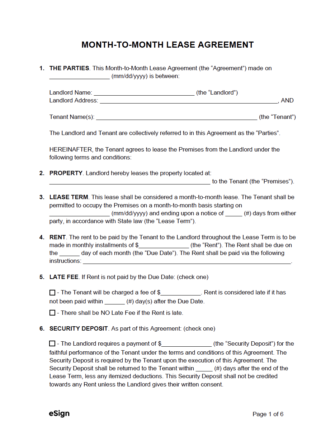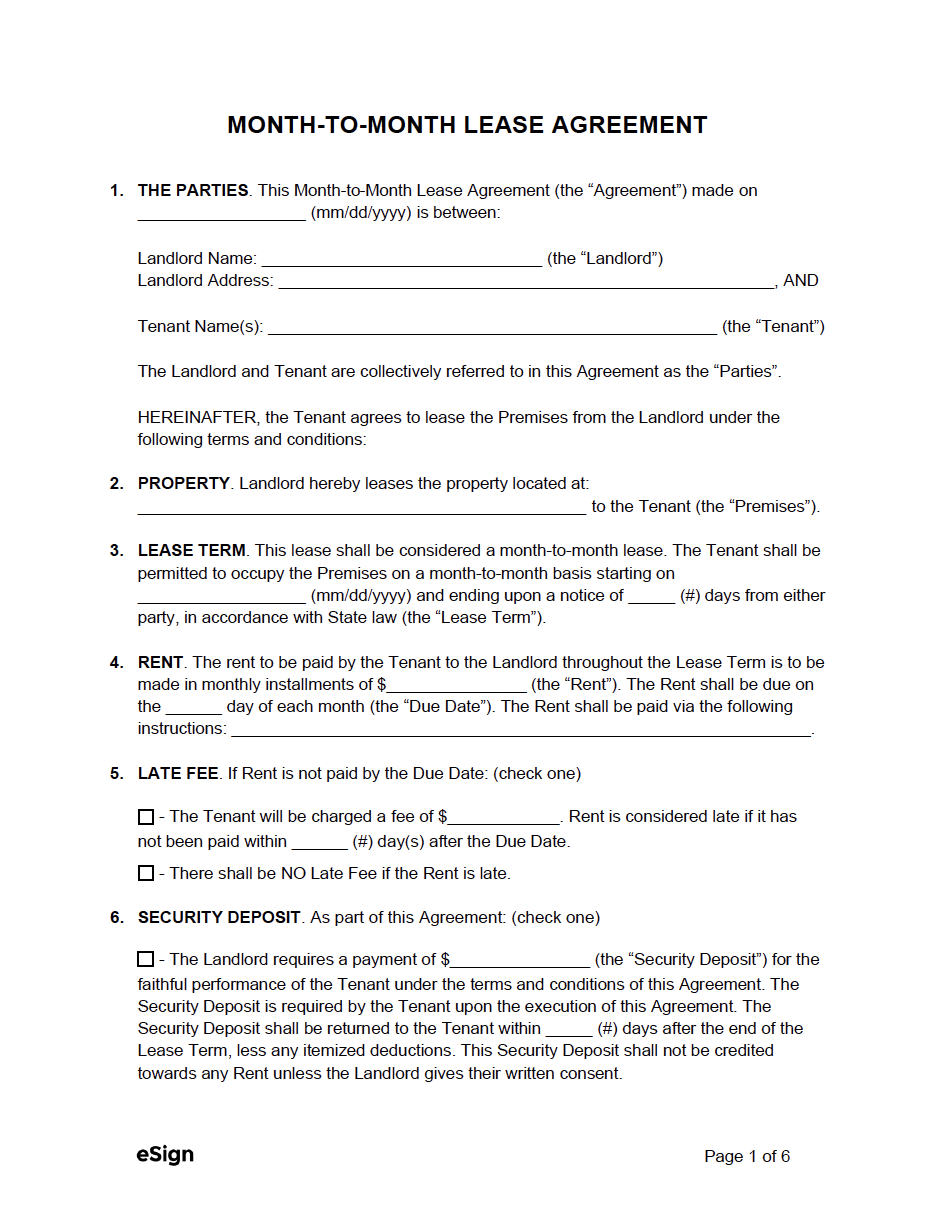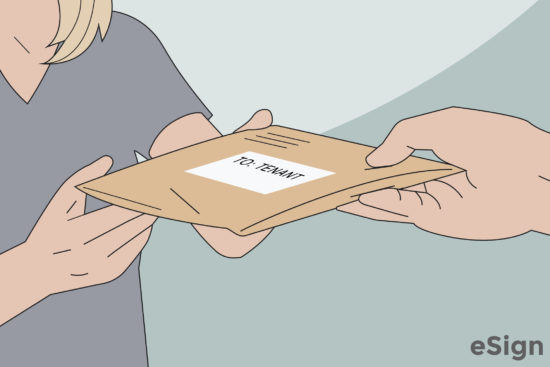By State
- Alabama
- Alaska
- Arizona
- Arkansas
- California
- Colorado
- Connecticut
- Delaware
- Florida
- Georgia
- Hawaii
- Idaho
- Illinois
- Indiana
- Iowa
- Kansas
- Kentucky
- Louisiana
- Maine
- Maryland
- Massachusetts
- Michigan
- Minnesota
- Mississippi
- Missouri
- Montana
- Nebraska
- Nevada
- New Hampshire
- New Jersey
- New Mexico
- New York
- North Carolina
- North Dakota
- Ohio
- Oklahoma
- Oregon
- Pennsylvania
- Rhode Island
- South Carolina
- South Dakota
- Tennessee
- Texas
- Utah
- Vermont
- Virginia
- Washington
- West Virginia
- Wisconsin
- Wyoming
How it Works (3 steps)
1. Write an Agreement
After a tenant views the space and is approved by the landlord, a month-to-month lease is written in accordance with the terms and conditions agreed to by the parties. Once signed, the agreement becomes legally binding.
Payments Required when Signing
- First month’s rent – Before move-in, the tenant is required to pay the 1st month’s rent;
- Security deposit – Usually equal to one month’s rent; and
- Last month’s rent – Depending on the landlord, the last month’s rent might be required (usually depending on the credit profile of the tenant).
2. Tenant Moves In
The tenant moves into the property and takes occupancy. While the tenant occupies the property, they will be required to adhere to the terms and conditions of the agreement until its end date.
Increasing the Rent
The landlord can increase the rent at any time by providing sufficient notice, commonly 30 days. If the tenant rejects the rent increase, they will be required to move out at the end of the rental period.
3. Terminate the Lease
A month-to-month lease is recommended to be terminated by completing a termination letter and sending it by Certified Mail with the United States Postal Service (USPS).
USPS ONLY!
Sending with 3rd party providers like FedEx and UPS is not considered legitimate notice (according to Leatherbury v. Greenspun (2007)). Therefore, it’s recommended only to use USPS when sending notice.
Required Notice Periods for Termination
| By State (Statutes) | |||
| STATE | REQUIRED NOTICE | SOURCE | |
| Alabama | 30 days | § 35-9A-441(b) | |
| Alaska | 30 days | § 34.03.290(b) | |
| Arizona | 30 days | § 33-1375(b) | |
| Arkansas | 30 days | § 18-17-704(b) | |
| California | Landlord must provide 30 days for a tenancy under one year and 60 days for one year or more.
Tenant can provide 30 days in all circumstances. |
§ 1946 & § 1946.1 | |
| Colorado | 21 days | § 13-40-107(1)(c) | |
| Connecticut | 3 days | § 47a-23 | |
| Delaware | 60 days | § 5106(d) | |
| Florida | 15 days | § 83.57(3) | |
| Georgia | Landlords must provide 60 days, tenant must provide 30 days. | § 47-7-7 | |
| Hawaii | Landlord must provide 45 days, tenant must provide 28 days. | § 521-71(a & b) | |
| Idaho | 1 month | § 55-208 | |
| Illinois | 30 days | 735 ILCS 5/9-207 | |
| Indiana | 1 month | IC 32-31-1-1(a) | |
| Iowa | 30 days | § 562A.34(2) | |
| Kansas | 30 days | § 58-2570(c) | |
| Kentucky | 30 days | § 383.695(2) | |
| Louisiana | 10 days | CC 2728(2) | |
| Maine | 30 days | § 6002 | |
| Maryland | Landlord must provide 60 days, tenant must provide 30 days. | (c)(3)(i) | |
| Massachusetts | 30 days | Ch. 186 §12 | |
| Michigan | 1 month | § 534.134(1) | |
| Minnesota | 1 month (minimum required termination period is equal to the payment interval or three months, whichever is less) | § 504B.135(a) | |
| Mississippi | 30 days | § 89-8-19(3) | |
| Missouri | 1 month | § 441.060 | |
| Montana | 30 days | § 70-24-441 | |
| Nebraska | 30 days | § 76-1437(2) | |
| Nevada | 30 days | § 40.251 | |
| New Hampshire | 30 days | § 540:3(II) | |
| New Jersey | 1 month | NJ 2A:18-56(b) | |
| New Mexico | 30 days | § 47-8-37(B) | |
| New York | 1 month | § 232-A & § 232-B | |
| North Carolina | 7 days | § 42-14 | |
| North Dakota | 1 month | § 47-16-15(2) | |
| Ohio | 30 days | § 5321.17(B) | |
| Oklahoma | 30 days | § 41-111 | |
| Oregon | 30 days | ORS 91.070 | |
| Pennsylvania | 15 days for tenancy under one year and 30 days for tenancy of one year or more. | § 250.501(b) | |
| Rhode Island | 30 days | § 34-18-37(b) | |
| South Carolina | 30 days | § 27-40-770(b) | |
| South Dakota | Landlord must provide 30 days, tenant must provide 15 days. | § 43-32-13 | |
| Tennessee | 30 days | § 66-28-512(b) | |
| Texas | 1 month | § 91.001(b)(2) | |
| Utah | 15 days | § 78B-6-802(b)(i) | |
| Vermont | 60 days for tenancy two years or less, 90 days for more than two years. | § 4467(e) | |
| Virginia | 30 days | § 55.1-1253(A) | |
| Washington | 20 days | 59.18.200(1)(a) | |
| West Virginia | 1 month | § 37-6-5 | |
| Wisconsin | 28 days | § 704.19(3) | |
| Wyoming | – | No statute | |
Sample
Download: PDF, Word (.docx), OpenDocument
MONTH-TO-MONTH LEASE AGREEMENT
1. THE PARTIES. This Month-to-Month Lease Agreement (the “Agreement”) made on [DATE] is between:
Landlord: [LANDLORD’S NAME] (“Landlord”)
Mailing Address: [MAILING ADDRESS]
E-Mail: [E-MAIL]
Phone: [PHONE]
Tenant: [TENANT’S NAME(S)] (“Tenant”)
Mailing Address: [MAILING ADDRESS]
E-Mail: [E-MAIL]
Phone: [PHONE]
The Landlord and Tenant are collectively referred to in this Agreement as the “Parties.” The Tenant agrees to lease the Premises from the Landlord under the following terms and conditions:
2. OCCUPANTS. The Premises is to be occupied with the following individuals allowed to reside on the Premises (in addition to the Tenant): (check one)
☐ – Occupants. [OCCUPANT(S) NAME(S)]
☐ – No Occupants.
3. PROPERTY. The Landlord agrees to lease a property to the Tenant located at: [PROPERTY ADDRESS] (“Premises”).
4. LEASE TERM. The Tenant shall be permitted to occupy the Premises on a month-to-month basis starting on [DATE] and ending upon written notice of [#] days from either party or the time period required under Governing Law, whichever is lesser (“Lease Term”).
5. RENT. The rent to be paid by the Tenant to the Landlord throughout the Lease Term is to be made in monthly installments of $[AMOUNT] (“Rent”). The Rent shall be due on the [#] day of each month (“Due Date”).
Payment Instructions: [PAYMENT INSTRUCTIONS]
6. LATE FEE. If Rent is not paid by the Due Date: (check one)
☐ – Late Fee Applied. The Tenant will be charged a fee of $[AMOUNT]. Rent is considered late if it has not been paid within [#] day(s) after the Due Date.
☐ – No Late Fee. There shall be no late fee if Rent is paid after the Due Date.
7. RETURNED CHECKS (NSF FEE). If the Tenant pays Rent with a check that does not clear due to insufficient funds, the following shall be applied: (check one)
☐ – Fee. The Tenant shall be required to pay a fee of $[AMOUNT] per incident.
☐ – No Fee. The Tenant will NOT be required to pay a fee.
8. SECURITY DEPOSIT. As part of this Agreement: (check one)
☐ – Security Deposit Required. The Landlord requires a payment of $[AMOUNT] (“Security Deposit”) for the faithful performance of the Tenant under the terms and conditions of this Agreement. The Security Deposit is required by the Tenant upon the execution of this Agreement. The Security Deposit shall be returned to the Tenant in accordance with the return period provided under Governing Law. This Security Deposit shall not be credited towards any Rent unless the Landlord gives their written consent.
☐ – No Security Deposit. The Landlord does not require the Tenant to pay a Security Deposit.
9. FURNISHINGS. The Premises is: (check one)
☐ – Furnished. The Landlord has furnished the Premises with the following items: [LIST FURNISHINGS]
☐ – Not Furnished. Property is not furnished except for the following items: [LIST FURNISHINGS]
10. UTILITIES. The Tenant agrees to pay for all the utilities and services in connection to the Premises EXCEPT for the following provided by the Landlord: [LIST UTILITIES & SERVICES]
11. PETS. The pet rules are as follows: (check one)
☐ – Pets Allowed. Pets are permitted on the Premises under the following rules:
Maximum Number (#) of Pets: [#]
Pet Types: [LIST ALLOWED TYPES]
Maximum Weight per Pet: [#] Pounds
Deposit: $[AMOUNT] / Pet
☐ – Pets Not Allowed. Pets are not permitted on the Premises except for those protected under Federal or State disability or emotional support laws.
12. PARKING. The Landlord agrees to provide the Tenant: (check one)
☐ – Parking. [#] parking spaces shall be provided ☐ on-premises ☐ off-premises that is: (check one)
☐ – Paid. A fee of $[AMOUNT] shall be paid monthly per parking space.
☐ – Free. Parking is provided complimentary as part of this Agreement.
☐ – No Parking.
13. SMOKING POLICY. The smoking policy is as follows: (check one)
☐ – Smoking Allowed. Smoking is allowed in the following areas: (check one)
☐ – All areas (unrestricted).
☐ – Specific areas: [PERMITTED AREAS]
☐ – Smoking is Not Allowed. Smoking is prohibited anywhere on the Premises.
14. GOVERNING LAW. This Agreement shall be governed by the laws of the State of [STATE] (“Governing Law”).
15. LEAD-BASED PAINT. The Premises was built (check one):
☐ – Prior to 1978. An attachment titled “Disclosure of Information on Lead-Based Paint and/or Lead-Based Paint Hazards” has been affixed to the Agreement and must be initialed and signed by the Parties.
☐ – 1978 or Later. No attachments are required.
16. SUBLETTING. The act of subletting by the Tenant is: (check one)
☐ – Allowed. The Landlord allows the Tenant to sublet the Premises provided that no agreement can be made between the Tenant and a subtenant for a period beyond the Lease Term.
☐ – Not Allowed. Unless written consent is granted by the Landlord in a separate agreement, subletting is strictly prohibited.
17. ADDITIONAL TERMS & CONDITIONS. [ADDITIONAL TERMS]
18. NOTICES. Notice can be sent by either of the Parties to the aforementioned physical and electronic methods as listed in Section 1 of this Agreement.
19. LANDLORD’S ACCESS. The Landlord has the right to enter the Premises for repairs, maintenance, or showings to prospective tenants, buyers, or other reasons. In the event of this type of entry, the Landlord shall provide at least 24 hours’ notice or the required notice as required under Governing Law, whichever is lesser.
20. EXECUTION. By signing below, the Landlord and Tenant agree to all terms and conditions of this Agreement.
Landlord: ____________________________ Date: _____________
Print Name: ____________________________
Tenant: ____________________________ Date: _____________
Print Name: ____________________________
Tenant: ____________________________ Date: _____________
Print Name: ____________________________




